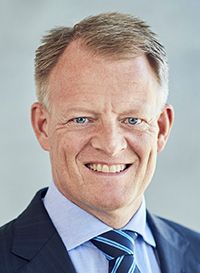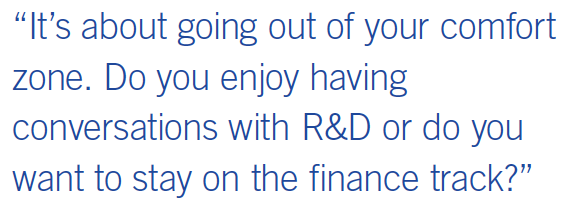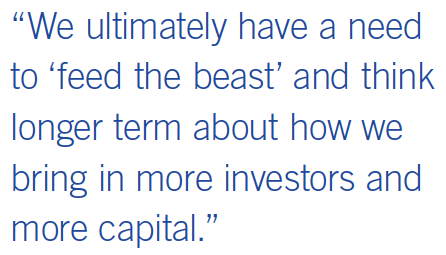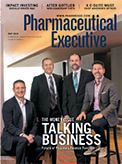The CFO Evolution
Pharmaceutical Executive
Pair of interviews spotlight the changing dynamics for C-suite business managers in two contrasting life sciences settings-big, established pharma and small, aggressive biotech.
In separate interviews, Pharm Exec speaks with a pair of C-suite business managers-one representing the perspective of big, established pharma and the other small, aggressive biotech-about the changing dynamics for today’s life sciences CFO.
First up: Anders Götzsche, Executive Vice President and Chief Financial Officer, Lundbeck
Focused on Challenges
Anders Götzsche on the winding road to his ultimate path: steering the finance arm during Lundbeck’s transformation to a multi-product company
Anders Götzsche, executive vice president and chief financial officer of Danish pharma giant Lundbeck, began his career as an accountant at PwC before pursuing an eclectic path that saw him serve as sales manager at leading software analytics company SAS, director at security firm Falck (now Group 4), and CFO of Copenhagen-based media organization Det Berlingske Officin. He joined Lundbeck as CFO in September 2007
Anders Gö

tzsche and has remained in that role ever since, overseeing a major period of restructuring that has seen the drugmaker expand its product pipeline and global footprint and achieve record financial results (in 2017–18). Between October 2017 and August 2018, Götzsche also served as Lundbeck’s interim CEO.
Pharm Exec caught up with Götzsche to discuss the highlights of his decade-plus tenure as Lundbeck CFO and his central role in the company’s evolution.
PE: Can you tell us about your background and your journey to Lundbeck?
GÖTZSCHE: After working at PwC as a chartered accountant, I went into sales in the software business (SAS), which was not a very traditional move, but I had been involved in some marketing activities in my previous role. At that time, a lot of people asked me, “Why don’t you stay at PwC and become a partner?”-but I wanted to develop my capabilities and skills. I was responsible at SAS for a division selling financial systems to large customers; I made cold calls and produced marketing plans. It was very valuable to learn how to manage those large customers. I then moved to Falck as director of investor relations and finance, and I was part of the activity that led to the merger of Falck with Group 4/Securicor.
I went onto become a CFO of a media group (Det Berlingske Officin, now Berlingske Media) with 4,000 employees and 60 different publications, including dailies and broadsheets. What I liked about that business was the daily rush of making decisions, mixing strategy with tactical operations. But I missed the international perspective. So when, after three years, I was offered the chance to join Lundbeck, one of the biggest companies in Denmark, and address some of the complexities and global challenges that pharma brings, it was too good an opportunity to say no to, and I have never regretted making that move.
PE: What were your priorities upon joining Lundbeck as CFO? Did you envision staying as long as you have?
GÖTZSCHE: I had spent eight years at PwC, but I was always looking for new challenges and experiences. What I found out at Lundbeck was not just that the pharma business is so interesting, but that there was always a stream of new and exciting challenges. When I arrived, we had to make a transition, as Lundbeck then was more or less a one-product company. So we made decisions to forge new partnerships, to stop the share buy-back, and to acquire a new platform in the US. We needed to streamline the business and enhance the value offering. It was a multifaceted program of restructuring and preparing the organization for change management. Since then, we have raised the profits to record-high levels, and have more than doubled our earnings and our share price. We have a very strong foundation now to pursue a new strategy of expansion and investment and further grow our revenue and earnings.
The CFO role here has been much more than a traditional finance role. If it had been simply that, then I think it may have become boring for me after 12 years. But, today, I have responsibility for all corporate support functions-legal, tax, investor relations, HR, communications, sourcing, business service-a very broad-based area of responsibility.
The pharma CFO role is a special one. You need to enjoy the scientific aspect and have an interest in the mechanism of action of the medications. You need to be close to the R&D organization. You need to be able to explain why your drug is different from others on the market and why it will make a huge difference to patients. And you get the chance to meet or communicate with those patients, whose lives your drugs may have changed and improved in significant and meaningful ways.
A strong CFO needs to protect the business from all the risks, but also understand that there is risk in this business and if we don’t take risks we don’t deliver new drugs for the patients. If we don’t do that, we’re not in business for the long run. From my perspective, the CFO role is about enabling the business to deliver fantastic results, deliver new medicines, and keep innovation alive in the organization. It’s also about going out of your

comfort zone. Do you enjoy having conversations with R&D or do you want to stay on the finance track? In some cases, a purely finance-oriented CFO may be exactly right for the organization. That is not what I wanted to be, but I have full respect that different profiles fit into different organizations.
I can look back after more than 10 years and say we have a stronger, leaner organization. We have a broader product portfolio, we have more than doubled our profit, and increased our revenue by more than 70%. That I feel is a great achievement. I have not done it alone of course; it has been about team work. An organization does not rely on one person; it needs leaders, but it also needs good people. That was something I continually emphasized during my run as interim CEO.
PE: How did you find making that transition to interim CEO?
GÖTZSCHE: It was quite tough at the beginning, having two jobs and stepping up to the plate to take that CEO responsibility, but you start the role on a high note because you are given so much confidence from the board. What I found I was good at was keeping the management team and the organization united and focused. When you look at the results of my tenure as CEO, I think they speak for themselves. It was great fun doing it and seeing the organization running really well. But I also really like my position as CFO, and so when we found our new CEO (Deborah Dunsire, who joined in September 2018), it was great to start forging a good relationship with her and get back to my main role. (Götzsche agreed with the board at the outset that his tenure as CEO would be temporary. “It is challenges, not necessarily my position, that excite me,” he told the Danish pharma news outlet, MedWatch.)
PE: We hear a lot of gloomy stories about the nature of big pharma going forward, about traditional models being broken. Do you remain optimistic about the next few years?
GÖTZSCHE:I believe there are a lot of opportunities. All companies, all industries, need to align to the new realities. It’s the same with pharma. There is still a need to improve patients’ quality of life. We know there are lots of areas where people are still suffering.
We need to look into those areas, for example, where we can develop medicines that use biomarkers, or where there are new solutions presented by digitalization, big data, and AI. I believe there is plenty of room for the biopharma industry to keep improving the lives of patients.
At Lundbeck, together with the rest of the management team, I want to continue to execute the new strategy, to build a strong pipeline, and to make new deals. The mid- to long-term ambition is to grow the organization, both from a revenue and an earnings point of view, and build an even stronger Lundbeck.
Next page: Shane Kovacs, Chief Finance and Business Officer, BlueRock Therapeutics
Banking on Success
Shane Kovacs on melding biotech operations and investment banking skills at stem cell startup BlueRock Therapeutics
Founded in 2016 to capitalize on the technological breakthroughs in the convergence of cell biology and genetic engineering, BlueRock Therapeutics (headquartered in Cambridge, MA) is advancing the company’s novel CELL+GENE™ platform to develop, manufacture, and deliver an entirely new generation of authentic and engineered cell therapies across three therapeutic areas: neurology, cardiology, and immunology.
Shane Kovacs

BlueRock Therapeutics was capitalized by Versant Ventures and Bayer in one of the largest-ever series A financings in biotech history ($225 million). Last year, the company tapped Shane Kovacs for the joint chief financial (CFO)–chief business officer (CBO) role. With a remit to help define and execute the company’s vision and apply its CELL+GENE™ platform across multiple therapeutic areas, Kovacs talked to Pharm Execabout how he is drawing on both his biotech operations and investment banking experience to help take the company forward.
PE: What is your background in finance and life sciences?
KOVACS: Growing up I was a math and science guy; my undergraduate degrees are in chemical engineering, life sciences, and economics. I worked in biotech in a lab position throughout my engineering summers. Then I migrated into finance and went to business school to formalize my business education beyond economics. Coming out of business school, I went into investment banking, where I focused on biotech and life sciences companies within healthcare. It was really a marriage of my two passions, finance and science.
I spent just shy of 10 years with Credit Suisse First Boston (now Credit Suisse), working on mergers and acquisitions and debt and equity raises for companies in the life sciences sector. I was raising a $65 million private financing for a private biotech in the fall of 2012 called PTC Therapeutics, which we were taking public in early 2013 when this whole wave of biotech IPOs really began. They were looking for a CFO and I was so excited about the prospects for the business that I decided I’d join them, so I flipped over from banker to CFO in May 2013. I spent about four years helping to run and grow PTC. It was an incredible experience and I learned about all facets of operating a biotech beyond just finance, including R&D, regulatory, and commercialization.
In early 2017 I was drawn back to Wall Street, but about six months in I realized that I wanted something more fulfilling for my career. I started talking to different VCs and was introduced to BlueRock, which was then less than two years old. I saw it was an exciting platform with disruptive potential for new medicines, using a cell as a therapeutic instead of a small molecule or an antibody. The company was well funded and there was a strong mandate from the board supporting an aggressive growth strategy. I felt that this was an opportunity where I could have a significant impact as a part of that management team.
PE: What have been your finance priorities since joining Blue Rock Therapeutics?
KOVACS: The company was founded in late 2016 with just two shareholders, Bayer AG and Versant Ventures, and while we are very well capitalized, our strong growth trajectory means that we’re very much a consumer of capital. So, we ultimately have a need to “feed the beast” and think longer term about how we bring in more investors and more capital. It’s also been necessary to put a whole organizational structure into place at the company based on our longer-term goals. That has really leveraged my operating experience at PTC and

understanding the nuts and bolts of a biotech company and what you need to do to successfully grow the operations. So we set up that structure, all of the different R&D departments supported by all of the different general and administrative teams, some of which had no employees at that time.
A major part of my job over the last nine months has involved the formation of the financial and capital strategy, positioning the company, building a website, getting in front of investors and getting their feedback. Also, I’ve had to build out the finance operation, because everything had been outsourced to third-party consultants from a finance perspective. I needed to hire the team and begin to implement all of the systems, processes, and procedures that will enable us ultimately to operate as a public company.
PE: How do you balance the CFO and CBO roles?
KOVACS: I think it very much depends on the background of your CEO, the rest of the executive team, and what backgrounds and skillsets they bring to the table. As a banker, I met many different executive teams of successful private and public companies. Sometimes you might have a CEO who’s well known in the community with a proven track record and has experience with capital formation and investor relations (IR). Perhaps that CEO doesn’t need a CFO who brings those skills to the table. Maybe that company is more suited to a traditional accounting/controller type, who can step into a CFO role and learn all the other external IR, strategy, and business development skills. I think you need an executive team that satisfies many different attributes or skillsets. And depending on the makeup of your entire team, you may or may not need a CFO that satisfies those needs.
When you move from banking to operating, you learn so much from your colleagues. It could be from your board members or your peers on the executive team from various other disciplines, such as your chief medical officer or head of manufacturing. I built a team of CPAs, for example, but I’m not a CPA by training. I understand accounting and am a chartered financial analyst, but I never did audit work. You learn along the way. It’s about understanding how to build teams and how to work with teams.
That sort of personal dynamic is very different from banking. But I’ve been able to apply approaches from banking. If you look at the Bulge Bracket investment banks, for example, they build teams by growing their own. They go out and find best-of-breed, if you will, from the top schools and they hire the top students-aggressive, smart individuals-and bring them in. I learned that from my banking days, and I brought that approach to building the teams at PTC and BlueRock.
As chief business officer, I’m also building out the business development team. We are very active in both search and evaluation of new innovative technologies to continue to enable our CELL+GENE™platform that we can either in-license or acquire. Additionally, we have been receiving interest from other parties interested in partnering with us and our platform. Going forward, that will also be an important effort at BlueRock.
For me personally, my ultimate career path is to pursue a CEO role in biotech. There are a number of precedents in our industry and it’s something I aspire to longer term. As a result, getting more involved and understanding other aspects of the operations of our business is a critical skill set I continue to build upon.
PE: What’s your vision for your company going forward?
KOVACS: The real goal for BlueRock is to bring game-changing therapeutics to patients and realizing the disruptive potential of a cell as a therapeutic.Our lead program is in Parkinson’s disease, and we hope to enter the clinic this year.
The trial is a surgical procedure using our authentic dopaminergic neurons as a therapy; we aim to reinnervate the human brain and reverse degenerative disease, potentially restoring motor function to the millions of patients suffering from Parkinson’s and potentially have a dramatic impact in a disease where there’s been very little innovation for the last 50 years.
We’ll know if we can achieve that in Parkinson’s in the next two years. To be a part of a company that could have a huge impact and leave a legacy like that is super exciting.
Julian Upton is Pharm Exec’s European and Online Editor. He can be reached at jupton@mmhgroup.com

The Misinformation Maze: Navigating Public Health in the Digital Age
March 11th 2025Jennifer Butler, chief commercial officer of Pleio, discusses misinformation's threat to public health, where patients are turning for trustworthy health information, the industry's pivot to peer-to-patient strategies to educate patients, and more.
Navigating Distrust: Pharma in the Age of Social Media
February 18th 2025Ian Baer, Founder and CEO of Sooth, discusses how the growing distrust in social media will impact industry marketing strategies and the relationships between pharmaceutical companies and the patients they aim to serve. He also explains dark social, how to combat misinformation, closing the trust gap, and more.